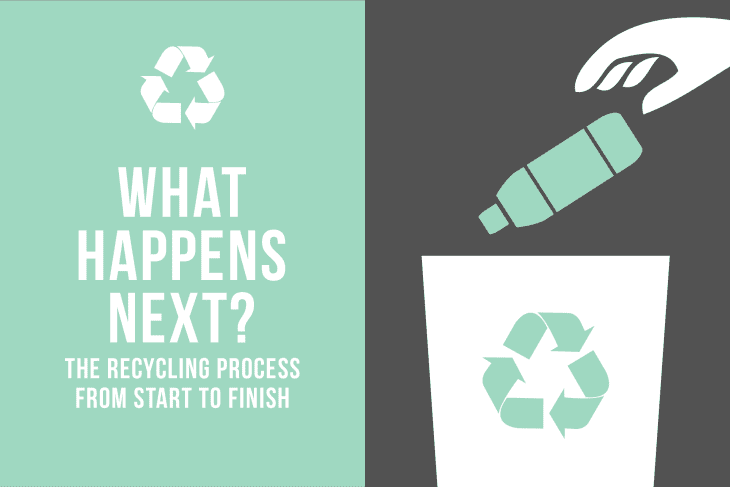Here’s What Actually Happens to a Plastic Container After You Recycle It

If you’re anything like me, you throw your plastic water bottle or yogurt container into the recycling bin when you’re done with it and pat yourself on the back for a job well done. After all, you’ve just done something, albeit small, to help the planet.
But what actually happens next? “The answer is way more complicated than people think,” says Heidi Sanborn, executive director of the California Product Stewardship Council.
While the exact answer varies depending on where you live and who ends up buying the recycled material, we tapped Sanborn and Bob Gedert, president of the National Recycling Coalition, to help us trace the steps that your yogurt container might actually go through.
What Happens to Your Recycled Plastic
1. You throw your yogurt container into the recycling bin.
Check your municipality’s guidelines, which will tell you how to sort your recyclables, where to put them, and other important things to keep in mind, like whether you need to rinse out your yogurt container before you recycle it (when in doubt, you should). “Every community has different standards,” says Gedert. “That’s why I always suggest people check.”
More on cleaning out your recycling: The One Thing You Should Always Do Before Recycling Anything
2. Collectors pick up recyclables and take them to a “murf.”
If your community has a curbside recycling program, then that would be from in front of your house — otherwise, you can look up how to recycle in your area.
No curbside? Find a recycling center: The Best Way to Find a Recycling Center Near You
Collectors then take your recyclables to a materials recovery facility (also known as a MRF, which the pros pronounce “murf”).
Fun fact: There are more than 2,000 MRFs in the U.S. Most people have one within 25 miles of their home, and they give tours! So you can visit your local MRF if you want to see it in action. “It’s fascinating,” says Gedert.
3. The plastic is sorted.
Once the yogurt container arrives at the closest MRF, it’s sorted by resin type — so if it’s made of polypropylene, it will end up with all of the other recycled goods made with polypropylene. “There’s mechanical separation and optic sorters and so forth, but there’s also a lot of hand sorting,” says Gedert, who notes that this creates jobs.
There’s one big caveat here: If your yogurt container arrives in a contaminated state (for example, if there’s too much Greek yogurt left on it or if it’s glass and the glass has broken), then it’s disposed of as waste and can’t be recycled. (That’s why it’s so important to follow your local recycling guidelines).
4. The plastic is shipped to another facility.
After the yogurt container is sorted at the MRF, it’s shipped off yet again — this time, to an intermediate processing facility. These companies take the sorted plastic and use machines to process it into flakes or pellets, which are then cleaned to remove any potential contaminants.
“It’s an industry standard type of material that can then be utilized throughout the plastics industry as a substitute for virgin plastic,” says Gedert. But since “virgin plastic” comes from an oil-derived material, recycled plastic doesn’t require drilling for oil and processing it — so it’s much better for the environment.
5. The recycled plastic is sold.
Companies buy the recycled plastic flakes or pellets (aka “feedstock”), which is then shipped to them. This company might be located across the country or across the world. “Traditionally, we have sent a lot of what is our waste or recyclables to China,” says Sanborn. “They have the low-cost labor to recycle it and send it back to us in value added (a fancy term for as a new product).”
But recently, China’s been accepting less and less of our recyclables. “Too much of what we send them is really trash rather than recyclables,” says Sanborn. “It’s a very serious problem.” It raises an important issue: We can sort plastic that has the potential to be recycled, but if companies don’t want to buy it and reuse it, then it will still end up in a landfill. “This is why we want people to use less plastic,” says Sanborn. “It’s too low-grade — no one wants it.”
6. The plastic is melted and reused.
In recycling lingo, these companies that buy recycled plastic pellets or flakes become “remanufacturing facilities” because they take the plastic and melt and press it down into new consumer products. “It could be a soap bottle, it could be a plastic auto part in your automobile, it can be formed into fiber for your carpet,” says Gedert. It could even be a new yogurt container.
Once you’re done using this new product containing recycled plastic, you can throw it in your recycling bin — beginning the process over again.
How Can You Know Where Recycled Plastic Is Used?
It’s not always possible to tell whether the goods you’re buying are made from recycled materials, as many companies are hesitant to advertise the fact that they use these Earth-friendly materials, says Gedert. “We have worked very long and hard to try to have a symbol put on the container that indicates that it has recycled content for it,” he says. “But advertisers think consumers have this belief that if it had recycled content it, would be an inferior product.”
If you disagree, you can vote with your dollars by making an effort to buy products that do brag about the fact that they’re made from recycled materials.